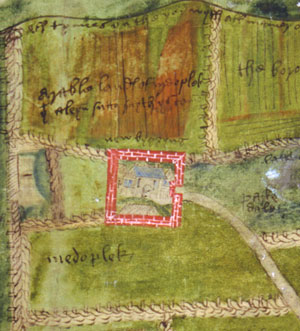 |
 |
 |
 |
 |
 |
 |
|
Later developments (8/15)
From the thirteenth century benefactions to Rievaulx waned. This was not peculiar to Rievaulx but was experienced by other Cistercian abbeys throughout the country and can be attributed, in part, to the arrival of the friars and competition for patronage. Another sign of the times was the growing complexity of the system of land-holding and the increased litigation that this brought. Land might be held only for a certain period rather than indefinitely; it might be exchanged for others. Consequently there was less permanence and security in land-holding which opened the floodgates to disputes and court cases. Legal disputes were sometimes resolved peacefully but might lead to ongoing friction and even to trial by battle. There was a case of this kind at Rievaulx, c. 1170, when one of Roger de Mowbray’s tenants, Alan of Ryedale, disputed Rievaulx’s right to common pasture in the stretch of moorland between Welburn and Bowforth, which Roger had given to the community in the mid-twelfth century. Alan claimed that this pasture was, in fact, part of his demesne, but Roger stood by his former grant arguing that this was common pasture. The matter was brought to Roger’s court when Alan actually obstructed the monks from accessing the land. The dispute was to be resolved through trial by battle and Roger summoned royal officials, his knights and neighbours as witnesses. When the dual commenced the knight championing Roger’s (and the monks’) cause looked likely to win and Alan was persuaded by his friends to drop his claims. Roger, accordingly, put the matter to twelve knights of the locality who agreed that this was indeed common pasture.(23)
A number of land disputes arose from disagreement over rights of dower, such as the case in 1202 between Robert of Kirkham and his wife, Albredam, and the abbot of Rievaulx over a messuage in Holmsile, which was held by Richard Tradesalt. The abbot was not always able to deal with every case in person, and on this occasion he was represented by his monk, Thomas.(24) A second example is the case in 1208 between Gilbert of Sauteby’s wife, Emma, and Abbot Warin of Rievaulx, concerning the third part of two bovates of land in Sheriff Hutton which Emma claimed as dower. This was resolved when Emma agreed to renounce her rights here to the abbot and his successors in return for a payment of 10s sterling.(25) Land disputes also arose between neighbouring Cistercians, for whilst the White Monks were united by bonds of unity and charity, this did not prevent disagreements from occurring within the family. Rievaulx was no exception and in the late twelfth century Abbot Silvan of Rievaulx and Abbot Robert of Fountains came to blows over land in Cleveland, where both abbeys had granges. The two parties were eventually reconciled, and agreed on boundaries and rights of way in this area.(26) Therefore, from the thirteenth century Rievaulx became increasingly weighed down by land disputes and court cases which could be costly, time-consuming and also damaging to the reputation of the house. This was by no means peculiar to Rievaulx and was experienced by other Cistercian abbeys throughout the country.
|
